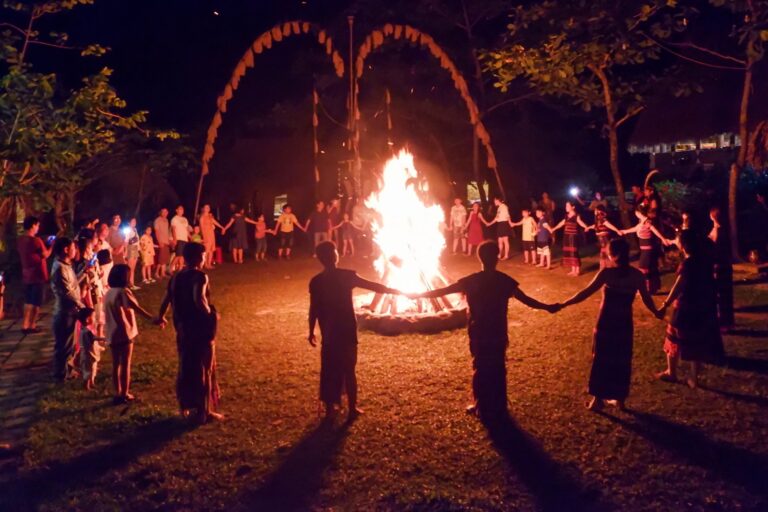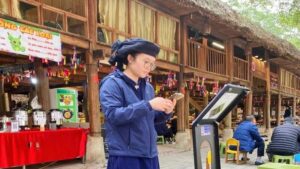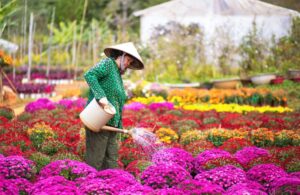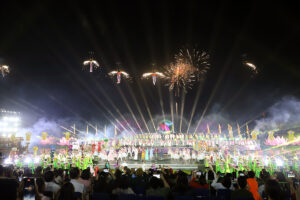The monthly celebration of the festival in Hoi An is sort of like a magical affair that leave tourists with happy memories.
Every month on the 14th day of the lunar calendar, Hoi An lets the moon take centre stage- the UNESCO protected old town switches off all superfluous lighting and motorcycles are verboten on the centuries old streets. Candles are lit and lanterns sway in soft breeze that blows up the Thu Bon river, which once allowed merchants and traders from China, Japan and Europe to sail into Hoi An – 400 years ago this was a thriving international hub hence the sublime architecture, which has thankfully been preserved and helping the town to once again flourish this time as one of Asia’s most magical tourist destinations.

Yes, every second house seems to be a shop, a restaurant or a tailor but the authorities have laid down strict regulations to ensure the charm of the architectural heritage is not compromised. Each houses’ façade retains an original appearance. The dimming of the lights and lighting of lanterns only adds to the town’s beguiling character.
This is why I always prefer Hoi An after the sun goes down. Locals and foreign tourists who have been hiding indoors or flopping round Cua Dai – the nearest beach to town – suddenly emerge in droves as a coolness descends on the town. No matter how many times I visit Hoi An, I always enjoy ambling around nibbling on the many tasty morsels on offer in the local eateries. With no traffic to irritate your senses, it’s a pleasure to sit out on the street down by the river.

You’ll know the festival is about to start when local boys emerge to perform a dragon dance. The cavorting dragon jumps to restaurants and shops in the hope of earning a small gratuity from the proprietor.
As the streets start to get crowded in anticipation of more performances, I slip up to the second floor of a restaurant overlooking the river and order a bowl or cao lau, a delicious dry noodle dish made with silvers of pork, bank da (rice crackers), a handful of local herbs and a blob of chili paste. I also order some white rose dumplings – tasty pork-filled morsels. Both of these dishes are local specialties and should be on everyone’s list of “things to devour in Hoi An” along with com ga, a simple but scrumptious take on chicken on rice, and the crunchy banh my pate sandwiches.

Down below by the river I can see women making and selling lotus-shaped garlands which come with a tiny candle. Tourists can row out in a boat and release the flowers onto the river while praying for happiness, luckiness and love. It’s a beautiful sight to see the flickering flight float off downstream.
When I descend to street level, the state next to An Hoi Bridge is surrounded by a throng of excided punters. A game called bai choi is underway. A band of musicians included a percussionist, a bamboo flautist and a two-chord fiddler sit waiting for people to but VND5,000 “cards”, which are not sort of like ping pong racquets. Basically, the cards have an inscription and the band performs depending on what cards they are dealt by the audience. An MC helps structure the event and explains the rules. Foreigners may at first be slightly mystified but will enjoy the spectacle with pleasant music and buoyant atmosphere.
Winners are awarded with silk lanterns or a CD of bai choi music opera. Sadly mu luck desserts me and after forking out VND30,000 I leave empty handed and head for the corner of Bach Dang and Chau Van Thuong streets and begin a session of retail therapy. Hoi An is awash with gorgeous silk products, which are a result of the cross-culture created by the Japanese, Chinese, Vietnamese and Cham people in Hoi An during the sixteenth and seventeenth centuries. The lanterns are perhaps the most iconic local symbol and make for nice decorative gifts.
Afterwards, I pass by the ornate gate of Fujian Assembly Hall, built by Chinese people from Fujian region over 400 years ago. This was firstly a traditionally assembly hall of Fujian people but later became a common temple for both Chinese and Vietnamese residents who came here to honour Lady Thien Hau, a goddess of the sea who protects sailors from danger.
On the night of the full moon, the temple looks splendid with red lanterns hanging above. All around town, altars – often placed out front – are laden with fresh fruit, flowers, votive papers and incense as homeowners and entrepreneurs make offerings to their ancestors and gods and pray for good business.
By eleven o’clock the streets empty out. Peace and quiet returns to Hoi An. The scent of wet aloe joss stick hangs in the air. The shops and restaurants have closed and only a handful of bars remain open. On the black roofs of ancient houses, dark green ferns and weeds quiver in the breeze. A mild, refreshing drizzle is falling. As I stroll back to my hotel, I can hear the sound of keys turning in bronze locks and wooden bars being drawn across as the town collectively heads for bed. I see one single lantern left hanging outside as I walk down an otherwise dark street and I imagine this is how the town might have appeared hundreds of years ago when these houses were first built and Hoi An was a proud and affluent port town.
















